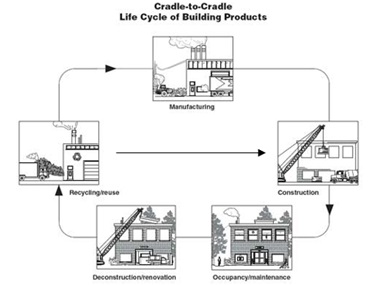by Emily Garbera — Facility managers spend most of their time focused on operating facilities and maintaining existing assets, so it is no surprise the ‘next step’ in asset management is often overlooked—what happens to assets that are no longer needed? It is inevitable that, despite even the most successful efforts to extend the life cycles of buildings, assets will need to be replaced. Renovations, equipment replacement, and building upgrades create unwanted materials at every facility. These waste materials can take the form of outdated office furniture, an obsolete HVAC unit, construction and demolition materials, and many others. As sustainability becomes a necessary reality of the future, it is essential that facility managers consider how they will replace unwanted materials from their facilities and whether these materials will end up in a landfill or find a new life.
What is waste management?
The classic waste management slogan, “Reduce, Reuse, Recycle” traces back to the 1970’s. The phrase and its visual companion, the three chasing arrows “Mobius Loop” recycling symbol, were created during a push for environmental awareness that emerged in response to society’s throwaway culture. The same decade also saw the creation of the Environmental Protection Agency (EPA) and the first Earth Day on April 22, 1970. Over the last 50 years, “Reduce, reuse, recycle” has paved the way for an emphasis on lifecycle thinking: evaluating all stages of a product’s life to reduce its environmental impact. When a product has reached the end of useful life for its current owner, waste management becomes important. Current methods of evaluating waste management expand “Reduce, reuse, recycle” into the waste hierarchy (see Figure 1).

Figure 1: The waste hierarchy of most preferred to least preferred waste management actions. (From Zero Waste Network, 2020)
The waste hierarchy emphasizes that preventing materials from entering the waste stream in the first place (“reduce”) is the most preferred method to manage waste. This is an ongoing process for sustainability-minded facility managers. However, once the waste exists, they must consider their options. According to the waste hierarchy, choosing to dispose of unwanted materials, although historically the go-to approach, is the least preferred option in terms of sustainability. In fact, the focus should be on reusing materials, followed by recycling.
Know your waste to control its fate
Every facility is unique, and therefore there is no one-size-fits-all approach to managing waste created by renovations, replacements, and upgrades. It is important to determine what types of waste materials will be created from each project. Facility managers should consider different categories of building waste that is generated, as it may influence how, or if, materials can be reused or recycled.
Construction and demolition (C&D) waste encompasses a large variety of materials and is likely to be found in renovation, rehabilitation, or other major building construction projects. These materials include concrete, wood, asphalt, gypsum drywall, metals, brick, glass, plastics, and carpet. Although most of these materials can be recycled or reused, the Construction & Demolition Recycling Association estimated that only 38% of mixed C&D materials were recycled in 2014, leaving a lot of room for improvement. The lifecycle of C&D materials can be extended by salvaging wood to remanufacture as other wood products, crushing concrete to use as construction aggregate, or sending scrap metal to be recycled.
Then there is furniture waste, also dubbed “f-waste.” Roughly every ten years, managers are pressured to update interior finishes in their buildings. Furniture becomes dated, tenants relocate, facilities need to be refreshed. Building furnishings, particularly office furniture, represent a huge source of waste. The EPA estimates that over 9 million tons of furniture waste end up in landfills each year. However, with a little research and planning, it is easy to give unwanted furniture a second life. Furniture can be sold to others interested in refurbishing items and reselling them or using these items themselves. Third-party resellers or liquidators are more likely to be interested if there is a large inventory available. A quick web search can reveal a variety of regional and national resources that buy and sell furniture. Alternatively, furniture can be donated to a community or organization in need. Organizations like IRN and the Furniture Trust connect donated office furnishings with schools and non-profit organizations, both locally and around the world.
Some facility waste may fall under special regulations established by the EPA. Equipment with certain hazardous materials including mercury or refrigerants have specific guidelines for how to be properly disposed. The EPA lists all applicable federal regulations on its website, which includes recommendations for recycling companies that can be found on its list of EPA-Certified Refrigerant Reclaimers. There are numerous other specialized recycling companies for building equipment such as HVAC, electrical, or electronics waste that will take responsibility for the recycling or disposal process. It can be confusing to navigate all of the information and resources available, but searches can be more easily focused by utilizing organizations that certify recyclers of a particular type of waste. For example, R2:2013 is a standard developed by Sustainable Electronics Recycling International (SERI), a non-profit organization that promotes safe and sustainable electronics reuse and recycling. SERI provides a database of certified recycling companies across the world that can be used to find a local certified recycler. In addition, some manufacturers provide take-back programs for old equipment. Once the equipment is in the hands of the manufacturer, it is convenient for them to reuse individual parts or send equipment to the proper recycling facilities.
Completing the cycle
Once facility managers understand the applicable waste management alternatives to disposal in a landfill, then they can help continue a cradle-to-cradle lifecycle of their building products (see Figure 2).

Figure 2: The impact of recycling and reuse on the lifecycle of building products. (From USDA Forest Service, 2013).
Unlike cradle-to-grave, where building products and materials are demolished and disposed of in a landfill at the end their life, recycling and reuse of materials significantly extends their lifecycle. When materials are recycled, they can be re-manufactured for a new purpose. Better yet, when materials are reused, they can be integrated directly back into the market with no need for re-manufacturing, which means less material and energy resources are needed to repurpose these items.
How do facility managers begin tapping into this cycle for their buildings? Joe Connell is a member of Build Reuse, a non-profit organization dedicated to increasing community awareness of the importance of reusing C&D materials. He says early project planning is key to ensuring materials that are no longer needed can be reused or recycled.
“First is the purchase of any new materials. The change must start there,” he said. “Making sure not to continue purchasing materials that have little of no value at the end of the buildings’ need for them.”
More often than not, the removal of unwanted materials is accompanied by the replacement of those items. For example, a lobby renovation could include disposal of outdated furniture and carpet, to be replaced with new furniture and hardwood floors. To ensure the sustainable building lifecycle, not only must sustainable options for waste management be explored, but also sustainable options for replacement, such as acquiring items refurbished for reuse or manufactured from recycled materials. The EPA, under its Comprehensive Procurement Guideline (CPG) Program, offers several resources to aid in this approach. One of these is a list of recycled material providers, organized by type of material, called the CPG Product Supplier Directory. The CPG program was established to designate products that can be made with recovered materials to extend material lifecycles.
The importance of the reuse and recycle initiative
The environmental benefits to sustainable waste management practices and material procurement are indisputable. However, an emphasis on reuse and recycling project materials may also help the bottom line. Disposal fees can add a substantial cost to a project depending on the type and amount of waste. Landfill tipping fees vary by region, with Waste Today magazine reporting that tipping fees in the U.S. ranged from approximately $155 to $30 per ton at municipal landfills in 2018, depending on the state. Construction and demolition materials must be taken to designated C&D landfills, but it is estimated that over half of C&D landfills in the U.S. set tipping fees at the same rate as their local municipal landfills. Ultimately, tipping fees can be reduced or avoided when materials are disposed of in a more sustainable manner. While some contractors might not be motivated to reuse or recycle based solely on disposal savings, such requirements can be written into project contracts.
Material reuse and recycling not only keeps materials from the world’s landfills, it encourages owners and managers to think about how their building lifecycles will continue. Joe Connell says it is important for facility managers to stay focused on the big picture.
“As we are seeing more and more, no industry or even person is an island,” he said. “We are all connected, and how we source and dispose of our resources are part of a chain of cause and effect.”
About the author
 Emily Garbera, E.I.T, is a Staff Engineer at Facility Engineering Associates, P.C. (FEA). She earned a degree in Civil Engineering from Virginia Tech focused in Structures, Materials, and Construction Management. At FEA, she works on providing engineering solutions related to roofing, facade, and other building envelope repair or restoration projects to maximize the life of physical assets.
Emily Garbera, E.I.T, is a Staff Engineer at Facility Engineering Associates, P.C. (FEA). She earned a degree in Civil Engineering from Virginia Tech focused in Structures, Materials, and Construction Management. At FEA, she works on providing engineering solutions related to roofing, facade, and other building envelope repair or restoration projects to maximize the life of physical assets.
Facility Engineering Associates wishes to thank Build Reuse for providing content support for this article.